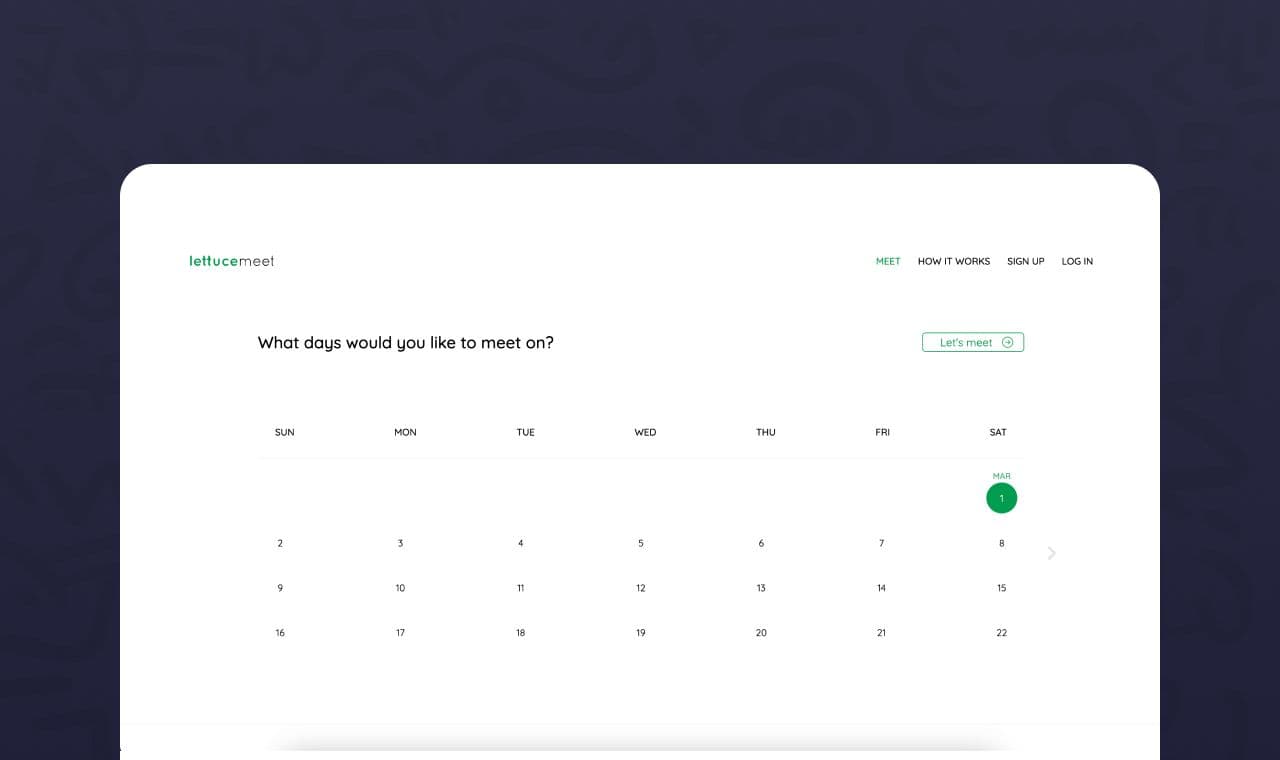The scheduling tool industry is awash with choices so it’s no surprise, perhaps, that developers are coming up with stranger names every year. When2meet is a simplified choice, and Koalacander conjures up an image of something cute and cuddly. One name, however, is more likely to draw raised eyebrows than others, and that’s LettuceMeet.
Yes, we heard that groan, the one that can only result from a bad pun. The name LettuceMeet is already stuck in your head, though, isn’t it?
It’s good marketing, but does the app itself stand up to scrutiny? Keep on reading for our guide to LettuceMeet and its various alternatives to find out.
LettuceMeet Overview
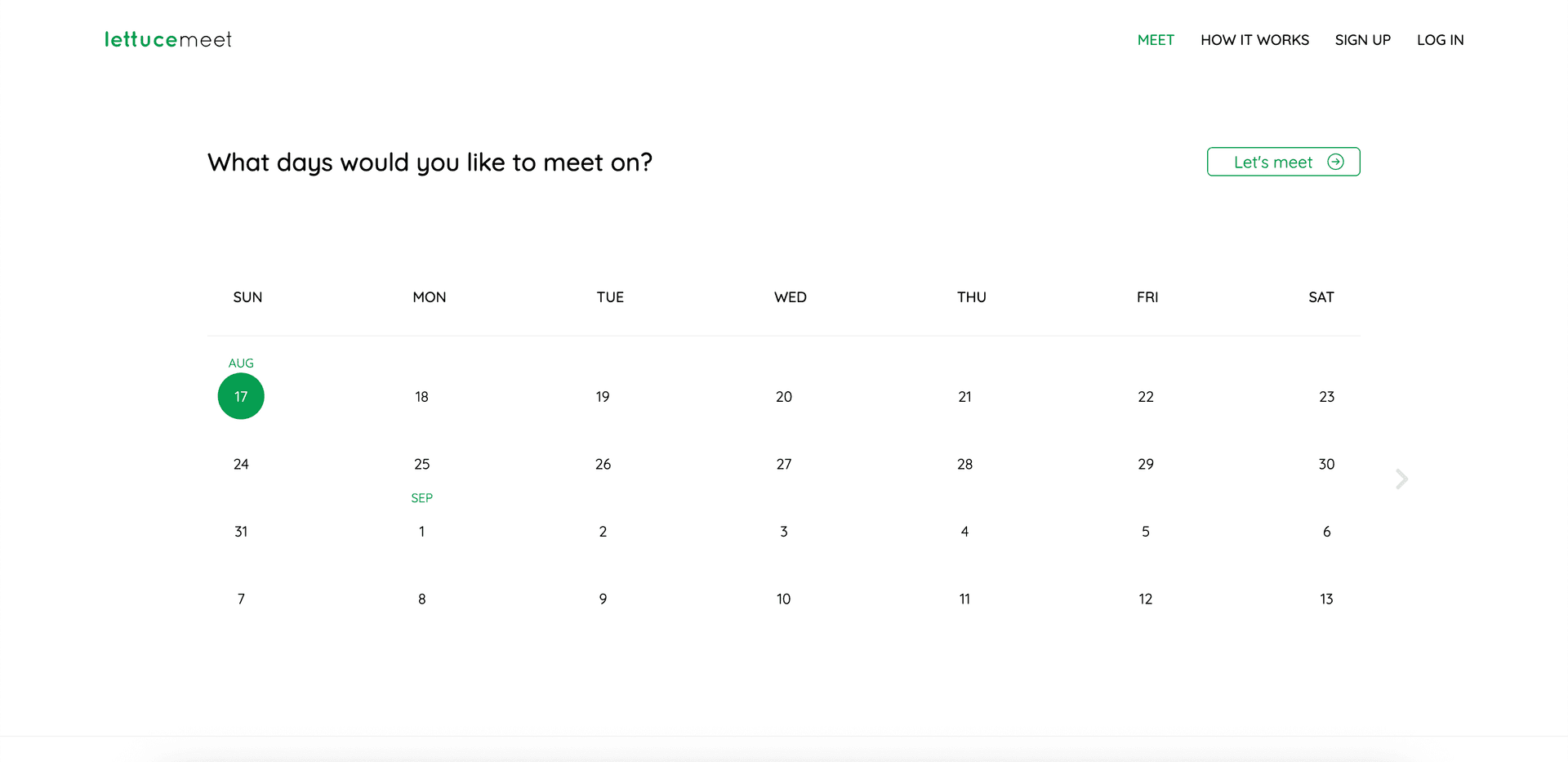
Let us meet LettuceMeet and find out what it’s all about. The first thing to note about this scheduling tool is that it’s designed to be as lightweight and simple to use as possible. It’s web-based and doesn’t require an account to access.
Participants of an event can access a shared link, select their available times, and the platform highlights the best options for everyone. As such, the tool has become primarily popular with those looking for casual meetups and study groups, like students and smaller-scaled work teams. Its simplicity carries over to its pricing model in that it doesn’t have one; LettuceMeet is entirely free to use, meaning this lettuce works well for those who think lettuce is a luxury!
Of course, this means that LettuceMeet can’t offer the advanced features required by many businesses and entrepreneurs. There are no automatic reminders, you can’t synchronize the tool with commonly used calendar apps like Google Calendar, and there’s no third-party tool integration either.
Key features
LettuceMeet is simplicity manifest. Let’s have a look in more detail:
- There are no sign-ups, no integrations, and no learning curve required. You simply create a link, share it, and let participants select their available times.
- It’s designed for people who need to arrange something quickly and casually, like a study session, coffee chat, or game night.
- It’s like an old-fashioned disposable camera; it serves a purpose and is then discarded; just switch the camera for a meeting link.
Intended audience
LettuceMeet was created with everyday individuals in mind, the kind of people who don’t need advanced features or complex calendar integrations. Its clean interface makes it accessible to virtually anyone looking to coordinate their meetings with just a few clicks.
The downside of this design philosophy is that LettuceMeet lacks the robust capabilities that businesses, entrepreneurs and others are likely to require. As such, LettuceMeet may feel too limited for people needing a business friendly scheduler.
Pros
- No sign-up required for organizers or participants
- Quick and easy to use, with a minimalistic design
- Completely free with no hidden costs
Cons
- Lacks integration with Google Calendar, Outlook, or other scheduling tools
- No automated notifications or reminders
- Limited functionality for professional and enterprise users
Pricing
LettuceMeet is 100% free for all users, but this means that you really are getting what you pay for.
Top 5 alternatives to LettuceMeet
How we did our research
We wanted to take a broad approach toward finding the best alternatives to LettuceMeet, so we decided to focus on four key factors that we would look for in each tool: simplicity, feature set, accessibility, and value for money. This meant that we weren’t targeting the same audience each time, as we wanted to provide as broad a range of alternatives as possible.
- Simplicity was our first priority, as LettuceMeet is known for being lightweight and user-friendly. People looking for an alternative would most likely want something similarly intuitive, without requiring complex onboarding or paid subscriptions to sign up.
- Depth of features was also paramount, as LettuceMeet falls short with its core features. We decided that our alternatives should offer improved and advanced capabilities like calendar integrations, automated notifications, AI-powered scheduling and more.
- Accessibility is also important. To ensure the alternatives we found during our research could reach as many people as possible, we took into account whether the tools were web-based, mobile-friendly, and required account sign-ups.
- Finally, we valued value for money, especially for students and small businesses. This made affordable or free plans a priority.
Thus, we chose factors that best represent a diverse set of scheduling solutions for as wide an audience as possible, while still providing value to those requiring accessibility. They’re generally easy to use, provide high-quality features, and won’t break your budget.
Calday
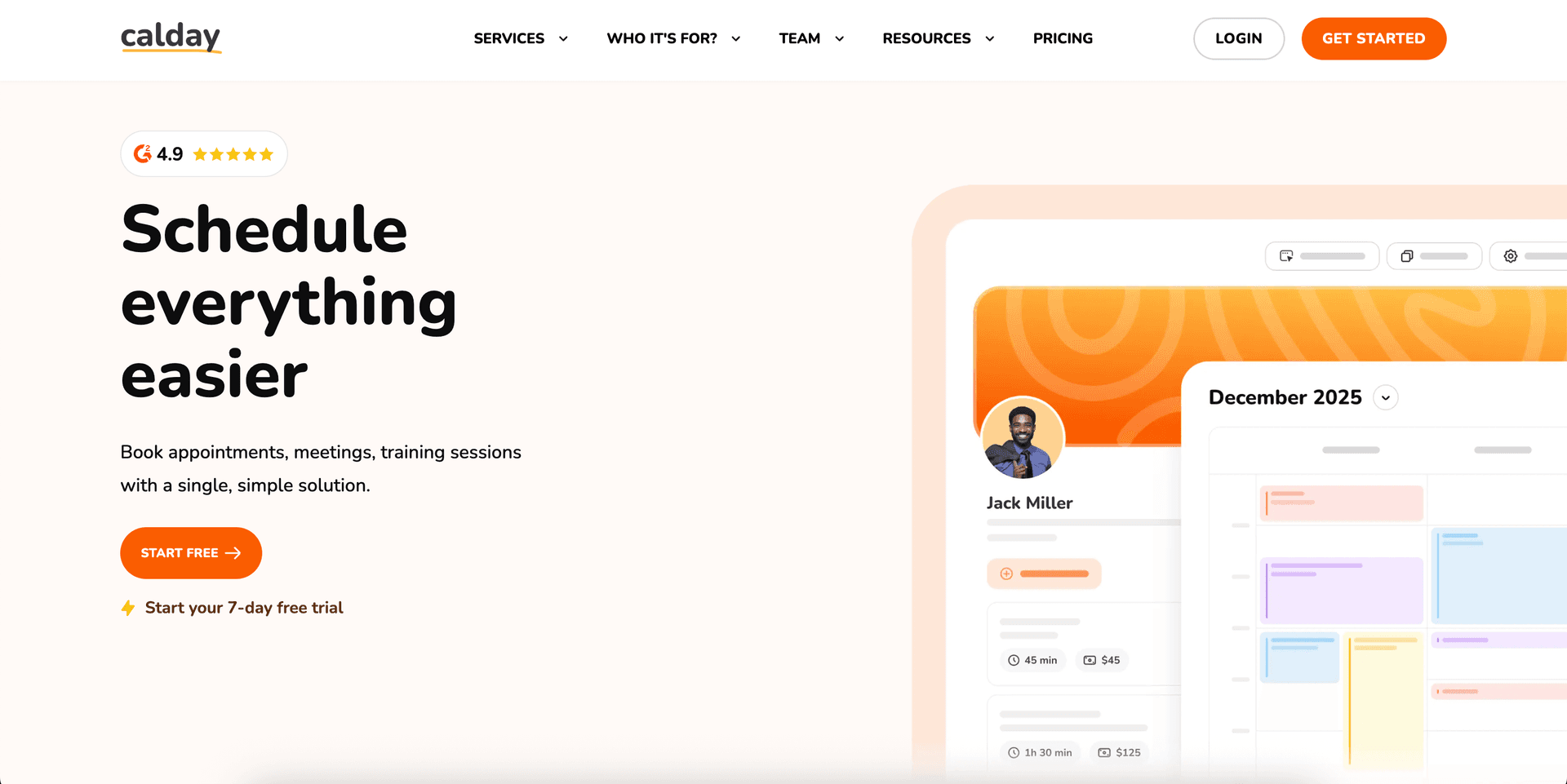
Overview
Lettuce works as a food because it’s simple, it’s a good addition to other things like sandwiches. You wouldn’t want to live off lettuce alone, though, would you? You need something more nourishing, tastier, something better, and that’s what Calday represents as a scheduler.
Calday is just as simple to use as LettuceMeet, even though you need to create an account to do so, and its benefits go so much further. We use some of the latest AI technology to power our app, taking a lot of the stress out of scheduling multiple events. We also support multiple third-party tool integrations, meaning that whether your contacts are using Google Calendar, Outlook, or another app, they’ll be getting the info you send them.
We’ve got everything you need to schedule effectively, whether as a business or an individual. Calday includes custom booking pages, group scheduling, and automated reminders as standard, everything you need to work on the go. At just $10 a month for a premium membership, we can meet almost any budget as well.
Key features
Calday is the best option available to you, and it has a number of cool features. One we’re particularly proud of is our customizable booking pages, which allow you to customize availability, meeting info, and whether you’re organizing 1:1s, group sessions, or team-wide meetings.
This level of control is invaluable for freelancers, consultants, and businesses who want to maintain a professional image while streamlining how others book time with them. It turns a basic scheduling link into a polished, branded touchpoint. For users needing flexibility and professionalism without complex setup, custom booking pages are what set Calday apart.
Intended audience
Everyone! Calday is designed for universal ease of use, whether you're a student juggling classes, a small business owner with piles of paperwork or even a retiree. Our intuitive interface and smart scheduling tools make managing time effortless for anyone
Despite offering some of the best advanced features available Calday remains cost-effective for all. Our premium plan costs just $10 a month, making it accessible even to students on a tight budget, and our free plan is very competitive.
Pros
- Integrates seamlessly with Google and Outlook calendars
- Custom booking pages enhance personalization
Cons
- Requires sign-up for both organizers and invitees
- Free plan has limited customization options (but our premium plan is very cheap!)
- There’s a short learning curve
Pricing
- Calday’s free version is a competitive product offering key functionality to average users.
- The premium plan is just $12 a month and provides some of the best features available on the market.
When2meet
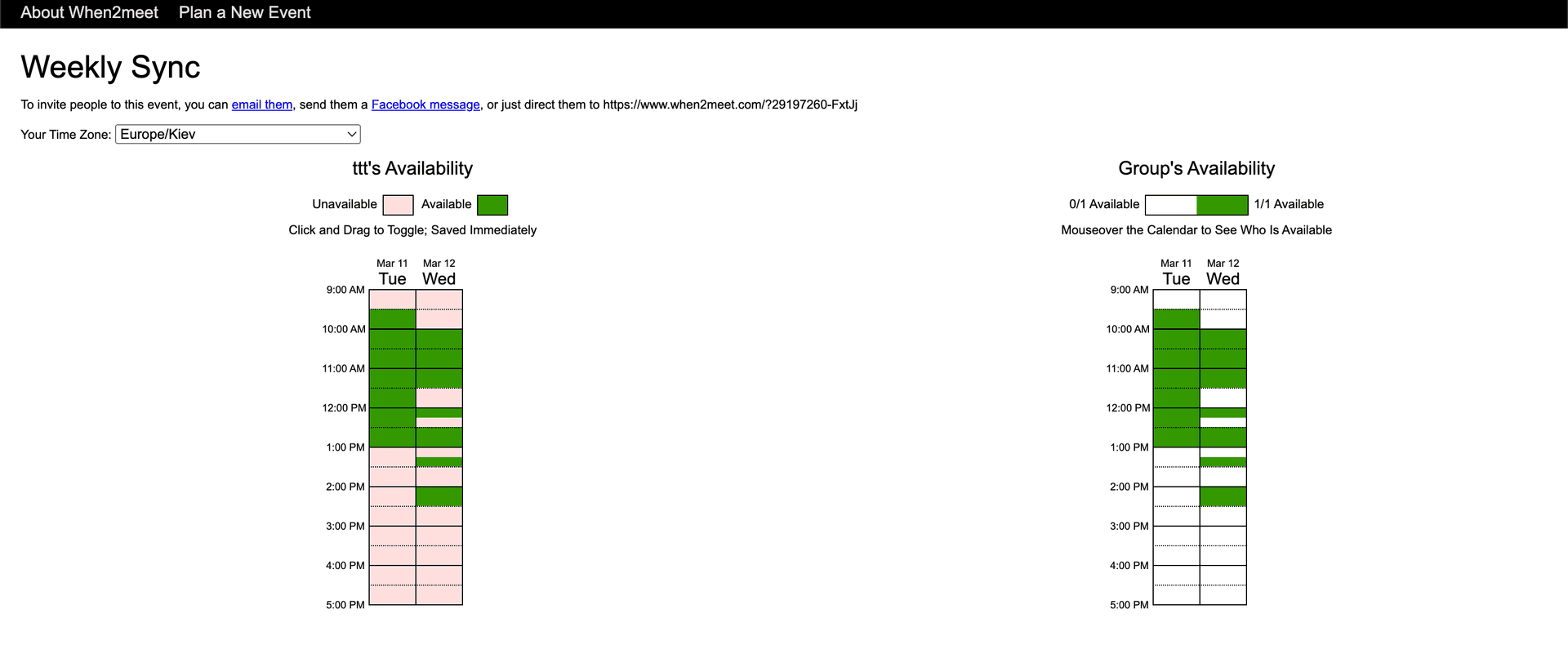
Overview
Lettuce meet When2meet (sorry, we can’t resist a good pun) and at first impression, it looks rather similar to LettuceMeet. There’s no requirement to sign up for an account, and it doesn’t need to be synced with any calendar apps you may have (it doesn’t sync with any mind you). As such, just like LettuceMeet, this app is very simple to access and use.
When2meet’s interface is worth drawing attention to, as it does have a pretty solid design. It uses an interactive grid where users mark their availability, and the system visually highlights the most suitable time slots for the group without requiring anyone to sign up, and of course, it’s free. However, like LettuceMeet, this simplicity comes with a price.
When2meet is best described as a disposable app, one that you use to set up a meeting with friends and then forget about. It has none of the advanced features you’d expect a business scheduling service to offer, and it doesn’t have any customization options either. The grid interface is pretty cool, but that’s about it, so those of you looking for a LettuceMeet alternative with more rigor should look elsewhere.
Key features
When2meet’s best feature is arguably its real-time availability grid, especially as you don’t need to sign up or create an account to use it. All the average user has to do is share a link and mark their available times on a visual grid, and as others do the same, overlapping times are highlighted immediately.
It’s simple, but it’s effective. Without the login requirement, there are no barriers or requirements for integrations that could put the more tech-averse off.
Intended audience
Exactly the same as LettuceMeet, When2meet is focused on people who need event scheduling for low-key events. It’s ideal for quickly coordinating social hangouts, casual meetups—anything where a sign-up process might put people off.
Students, retirees and those who aren’t consistently online are therefore the key audiences this app caters to. As a result, it’s not a good fit for businesses or anyone needing more powerful features like calendar integrations, reminders, or attendee tracking.
Pros
- No sign-up required for users
- Quick and easy visual interface
- Works well for large groups
Cons
- No integration with external calendars
- Outdated interface with a basic design
- No automated notifications or reminders
Related
You might also find our tips on exploring other When2Meet-like tools and making the most of meeting pools helpful.
Doodle

Overview
Some scheduling apps have their own unique selling point rather than being a jack of all trades, and this was the model adopted by Doodle. Unlike LettuceMeet, Doodle is based on the ability of users to create polls where participants can vote on preferred meeting times. This is pretty advantageous for those organizing large groups, as instead of a chain of emails, all they need to do is access a link.
This naturally represents a step up from what LettuceMeet offers, and this isn’t the only feature that lets Doodle trump the lettuce. It has an automatic time zone detector, which ensures that meeting times are displayed correctly for all participants, no matter where they are located. This has made the app popular among companies and small businesses working across borders.
However, while Doodle is a considerable step up from LettuceMeet, its advanced functions are similar to most other high-quality scheduling apps. The premium version of the app, which lets users access its best features, ranges from $6.95 to $8.95 per user per month. This cost is low individually but can spiral for a company, so it may not be the best investment for smaller entities.
Key features
Doodle’s best feature is, of course, its poll-based scheduling—its unique selling point that has proven popular with a wide range of users. It provides a democratic approach to events organization, ensuring that consensus can almost always be achieved when setting events up.
The poll system doesn’t just ensure that every potential attendee’s voice is heard; it also eliminates long email chains and confusion over time zones. This ability to cut through the paperwork and the background noise is obviously valuable, especially for international businesses.
Intended audience
Doodle is targeted at those who want the simplicity of access provided by When2meet and LettuceMeet but also need a little more power to drive their events organization. Students, etc., can use the app for arranging study sessions, but its core audience is smaller-sized businesses.
It’s simple to use, but effective functionality combined with automatic time zone adjustment makes it highly effective for committees and board meetings. Companies working with distributed teams, or groups with members in various locations, have responded particularly positively to Doodle as a result.
Pros
- Poll-based scheduling simplifies group decision-making
- Works well for teams across different time zones
- Paid plans include calendar integrations and automated notifications
Cons
- Free version includes ads, which can be distracting
- Manual selection of meeting times in the free plan
- Some users find the interface slightly cluttered with too many options
Pricing
Doodle offers a basic free plan that includes one booking page. To access all of the app’s features. Individual premium plan and the team plan are priced at $14.95 and $19.95 respectively.
Related
You might also find our tips on exploring Doodle alternatives and optimizing group polls useful.
Calendly

Overview
Calendly is currently one of the most popular scheduling apps available, and it’s not hard to see why, especially when you compare it to a simple tool like LettuceMeet. It’s easy to see the availability of meeting organizers and potential participants on its interface, the booking system is efficient, and it syncs with many third-party tools. Some of these integrations include Google Calendar, Outlook, Office 365, and Apple Calendar, meaning almost anyone can get linked to Calendly.
Calendly’s automation is particularly impressive, allowing users to create and organize events with barely any effort. Unlike LettuceMeet, Calendly users can set up workflows to send email reminders, follow-ups, and thank-you messages. All of these can be customized to their preferences, ensuring that every event and its follow-ups are individualized.
Where Calendly famously falls short, however, is in its customer service. It’s a good thing that everything is automated because if something does go wrong, you’re basically on your own. On the British corporate review website Trustpilot, Calendly only has a 1 out of 5 rating; a shockingly low score for such a commonly used app.
Key features
Calendly is designed to appeal to as many potential users as possible; however, its core audience is arguably businesses. The system’s key features, including automated email reminders and calendar integrations, have the most impact for those who need business scheduling.
We would sound a note of caution here, however, as the premium version doesn’t unlock Calendly’s full range of features. To access all of them, you need to sign up for an enterprise plan, putting the app out of reach for many potential users.
Intended audience
Calendly’s most notable feature is its workflow automation, and it’s one of the main reasons why the tool has become popular with businesses. It allows users to set up sequences to send confirmations, reminders, follow-ups, and custom thank-you emails in one process.
This process also allows the user to integrate with major third-party apps without any manual coordination. It’s a pretty powerful feature, and it can save a lot of time for business professionals.
Pros
- Automatically syncs with multiple calendars to prevent scheduling conflicts
- Offers workflow automation for reminders and follow-ups
- Custom branding and professional booking pages in paid plans
Cons
- Can be overwhelming for users who only need simple scheduling
- Advanced features require a paid subscription
- Some invitees may find the interface confusing if unfamiliar with scheduling tools
Pricing
There’s a basic free plan on offer but to access Calendly’s best features you need to pay for its premium versions. These ranger from $10 to $16 for individuals and teams respectively.
Related
You might also find our tips on trying out Calendly alternatives and managing scheduling links more effectively useful or discover Calendly pricing
Koalendar
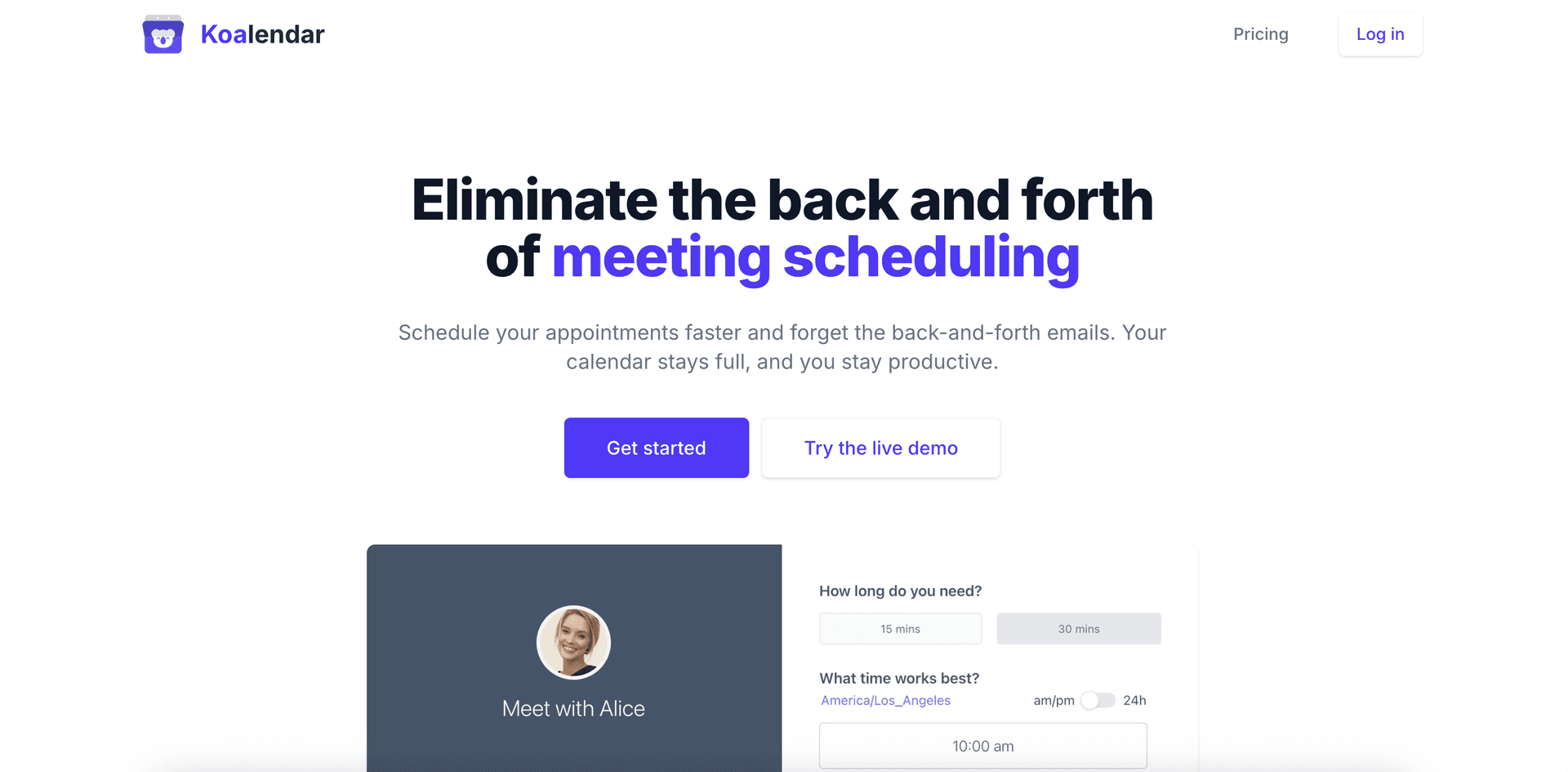
Overview
Lettuce meet (sorry we’re not sorry) the last of our LettuceMeet alternatives, and that’s Koalendar, a scheduling app that takes inspiration from down under. It’s more sophisticated than the former app as it uses AI-driven analysis to streamline appointment booking. It does this by analyzing past behavior and user preferences to create intelligent scheduling options.
As you can imagine, this option is a lot more intelligent than LettuceMeet, but its interface is still relatively simple. It comes with an automatic time zone adjuster like some of our other entries, and it includes all the classic integrations you’d want from a good scheduler. However, if this sounds too good to be true, you’d be right.
The AI-driven automations are pretty basic, and if AI-driven scheduling is your essential thing, there are definitely more advanced options available. Unlike Calday, it doesn’t offer CRM integration either. So overall, while it has a cute and cuddly name, it delivers about the same level of intellectual performance as its namesake.
Key features
Koalendar stands out for its ease of access, and its interface has won plaudits for being user-friendly. The booking page makes it easy to sync with third-party apps like Google Calendar and Outlook, and there are some decent customization options.
Each user can display their time zone as well via Koalendar’s built-in time zone recognition. This makes it valuable for people working in different teams in different locations, whether they’re in business, academia, or engaged in other fields.
Intended audience
Koalendar was initially designed with small businesses in mind; however, it has since become more of a general audience tool. Its AI functions help most people who use it get the most out of it, and basic automation benefits almost everyone too.
The downside of being a jack-of-all-trades solution is that it offers something for everyone, but not that much. As such, investing in a tool like Calday, which has more robust features, is recommended.
Pros
- Easy-to-use interface with minimal setup required
- Automatic time zone detection for international scheduling
- Google Calendar, Outlook, and Zoom integrations
Cons
- Limited advanced automation compared to other apps
- No CRM integrations like HubSpot or Salesforce
- AI-powered scheduling can be inaccurate
Pricing
There’s a basic free plan and the premium version starts from $6.99 per month.
Summary
Make sure you make the right choice when selecting the best event scheduling tool for you. For affordability, depth of features, and reliability, there’s only one real choice—and that’s Calday.
Sign up today by following the link; it’s easy to create an account and get started. In no time at all, you’ll be wondering why you put up with stressful scheduling for so long.

